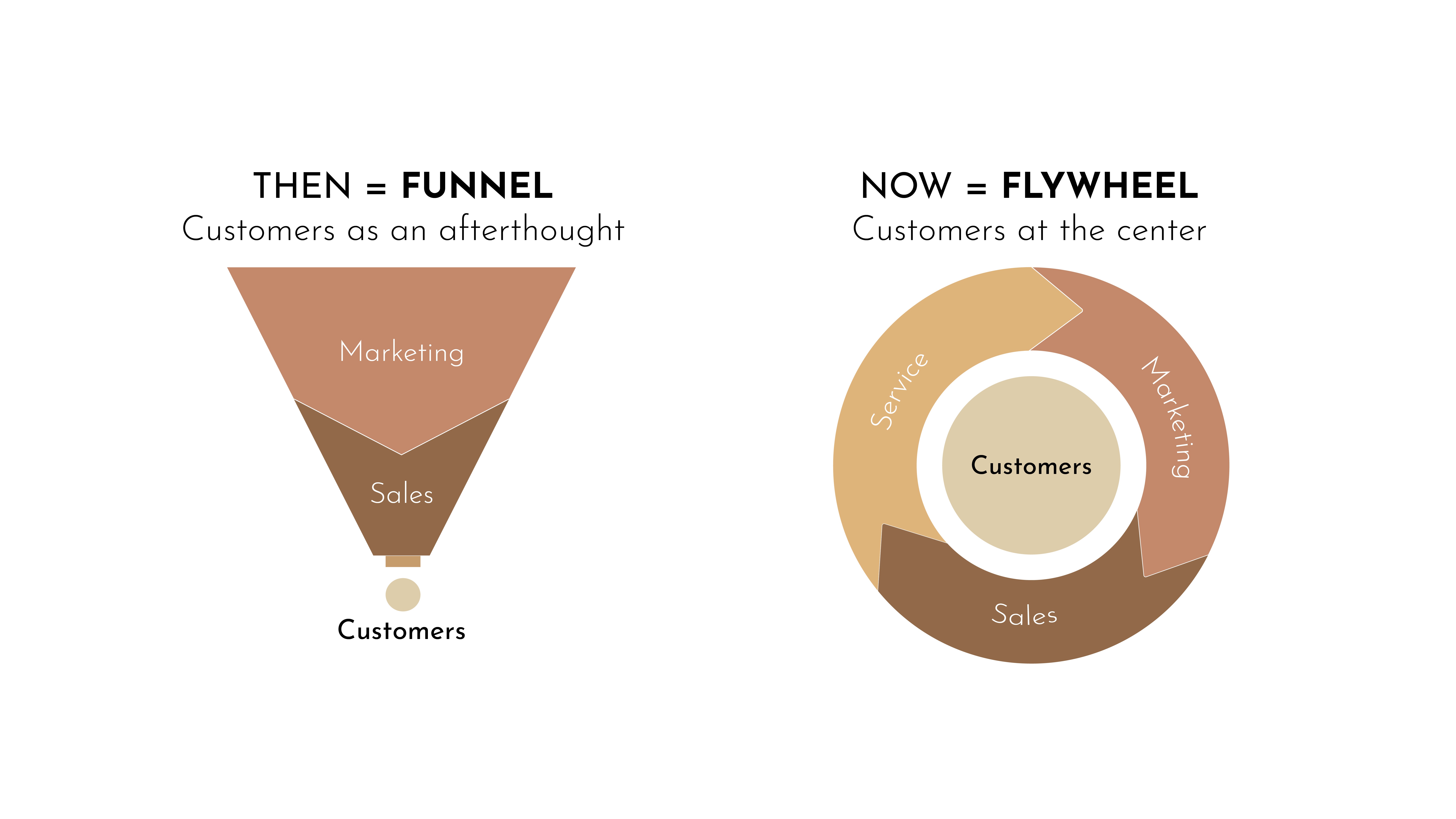Finally more referrals with the Flywheel

Like so many things in life, the sales funnel has evolved. Although many online marketers have only heard of it since the rise of online marketing, it is one of the oldest (and most successful) sales models in the world. But now it is being superseded.
In this article, we'll go over what's new in the market and why the "Sales Funnel" is being replaced and should be replaced by the "Flywheel".
The sales funnel briefly explained
The Sales Funnel can look back on a long history. It was invented in 1898 in the course of the development of the AIDA formula:
- Attention
- Interest
- Desire
- Action.
Thus, the journey of a prospect to a customer was born. At the same time, the formula also represents a cornerstone of today's online marketing thinking: the so-called customer journey through the sales funnel. This is used to explain marketing and a specific marketing strategy in a tangible way, so that errors and weaknesses can be identified and possibly optimized with the help of the AIDA formula.
Until now, online marketing has worked flawlessly with the help of this system. In the context of digitization, trust in traditional sources such as television or print editions of magazines began to suffer. Instead, the online marketing of the future is taking place within the framework of a new form of word of mouth. Recommendations from trusted friends and acquaintances are achieving greater penetration than ever before. The principle of "recommendation by friends" has become influencer marketing. This embodies the "funnel" like no other distribution channel: first, a target group is addressed through images, videos and texts and their basic interests (e.g. fashion, food, music...) are served. These are bundled into "extended interests," i.e., products and services are promoted within the posts of the influencers that could be exciting for the group of basic interested parties. Since the "digital friends" and "stars" use the same products, the consumer group develops the need to own them until a purchase is made.
Accordingly, the funnel works by: 1. attracting attention (Attention), 2. creating interest (Interest), awakening need(s) (Desire), and 4. prompting action (Action). - Ergo: the AIDA principle.
The problem of the sales funnel in (online) marketing
Probably the biggest problem with the sales funnel is its linear mode of operation. Consumers and prospects hardly ever enter the buying process via the argument of attention. Contrary to classic advertising formats, many people have become immune. Market shouters and print media based on the watering can principle have long since become obsolete. Instead, prospects also orient themselves on other levels of the classic AIDA formula, (apparently) entering the funnel at any time or jumping back and forth on the levels.
In both the B2B and B2C sectors, customers are faced with an enormous amount of knowledge and information. They can obtain comprehensive information about products and companies on the Internet, and seek reassurance from colleagues and friends. Prospective customers create a funnel for themselves, so to speak, and walk through it on their own. Whether they subsequently pass through the door of purchase is no longer guaranteed by the "sales funnel".
Furthermore, the sales funnel cannot absorb any new momentum. As a result, leverage and momentum are lost. What is meant by this? - Let's say a potential customer sees an ad for a kitchen appliance in a paid Google Ad. He now searches for suitable online articles to find out more about it. He then buys the product in the online store or in the electronics store he trusts. This means that the customer has completely passed through the sales funnel and the sales process itself is complete. The disadvantage of this method is that the customer is a "one-time customer". According to the funnel principle, one would now have to recruit him completely anew in order to let him become a customer again. The "momentum" is therefore lost.
In summary, this means that the funnel has to be restarted again and again after a certain period of time. This not only costs money, but also time and thus customers.
The sales funnel becomes a flywheel - online marketing rethought
The constant conception and use of different funnels does not only have disadvantages. After years of building up so-called inbound marketing via funnel systems, companies can point to some important advantages over outbound marketing: Backlinks to websites, social media followers as well as evergreen content. Accordingly, without wanting it fundamentally, an already permanent content stream was created that can constantly recruit new customers. The funnel system has thus been automated.
Theoretically, entire marketing departments could retire - after all, new customers are constantly being generated thanks to the automatic mechanisms. - But that's where the error in thinking lies. At some point, the end simply comes. You can't generate new customers on a permanent basis by playing out the same funnel systems over and over again. Instead, existing customers must be encouraged to recruit further customers or to be active as buyers themselves time and again.
What is needed, therefore, is a circuit. Corresponding to a flywheel.
The reinvention of the flywheel
Basically, the concept of the flywheel (or "flywheels") is already "somewhat older" and goes back to the mechanical flywheel. It was invented about 200 years ago. James Watt used it in his steam engine at that time. Efficiency at the highest level as well as the capture and storage of energy were made possible with it.
In marketing, using a flywheel is about as revolutionary as it was 200 years ago. It captures, stores and releases a higher concentration of your own energy in the form of traffic, leads, sign-ups, new customers and the enthusiasm of existing ones. The system works on the metaphor of pressure and momentum. Loss of energy here means the loss of users and customers, which at the same time also counteracts the dynamics and slows down the growth enormously.
The flywheel is kept running by applying force. The more set screws are attached to the wheel, the more force can be exerted. This is how speed is achieved. With the Flywheel, in contrast to the Sales Funnel, customers are not "pushed through" but involved in a cycle. Nor can the funnel help companies effectively leverage the growth generated by customers.
With the Flywheel system, customers are inspired. Customers and visitors are encouraged to do their own advertising in the form of word of mouth, which ultimately gives the wheel further strength and momentum. So the whole difference is to focus on the whole customer experience, the relationship with the customer, with the Flywheel.
Other choices through the flywheel
Marketing legend Brian Halligan's slightly modified Flywheel model explains how modern marketing works today:

In the first third of the cycle, potential customers are attracted in the sense of the inbound marketing process. This covers the "attention and interest chain" of the AIDA formula. The aim of the initial process is to establish a relationship of trust with the customer.
Here you can work with the following building blocks:
- The heart of inbound marketing: the necessary content can be a blog, a podcast, video channel or even a membership. The content should be carefully created and always keep in mind the problem or desire of the potential customer.
- SEO: Without optimizing the content, you will not attract visitors to the website or to the business in general, and consequently no potential customers. This is also why high-quality content is the motto here, on which inbound links can then be built.
- Nothing works without social media anymore: Customers should be able to become aware of the product by chance. Regular maintenance of the social media channels is mandatory here.
- Involvement of influencers! These new faces of marketing are enormously important to get in close contact with certain(!!!) target groups and to keep it.
- Affiliate and paid ads as reach boosters.
In the flywheel, the phase of pro-active action takes place in order to be able to build a lasting relationship with the potential customer. Call-to-action is the magic word here. This can be, for example, a newsletter via email or Facebook message to. The visitor gradually develops into a customer through constant contact.
In the classic sales funnel, this would be the end. In the flywheel, the customer is encouraged to attract more (other) customers or to continue being a customer himself through sustained enthusiasm and involvement in content production. In principle, the Flywheel describes the basis of successful referral marketing. If existing customers are encouraged to take part in the marketing process on a sustained basis, they can inform other people about the content and thus, metaphorically, keep the flywheel turning faster and faster in line with the old system of the flywheel.
Final thoughts: What does this mean for you?
You are a client of an online marketing company (at best Golden Web Age):
It is a quality characteristic of a good (online) marketing strategy to be medium to long-term. This means that while being careful not to lose sight of the methods and the spirit of the times, and to innovate accordingly. But it is important to understand that customers are attracted sustainably(!).
So ask how your website, promotions, etc. can generate sustainable customers or what should be done for this. In this way, you capture every marketing strategy in its entirety right from the start.

